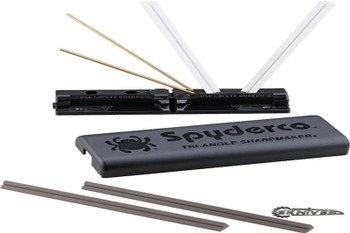Pro Tips for Keeping Your Knives Sharp and Pristine
Posted by Clayton on Jan 26th 2017
From collectors who display their knives to professionals who require a quality knife for their job, you need to know how to properly sharpen a blade.
Quality knives are a significant investment, so it's important to maintain them properly. Over time, improper maintenance and lack of care will result in a dull and ineffective knife. Here are some tips for extending the life of a knife and keeping its blade sharp and pristine.
Sharpen and Hone
Frequently re-sharpening the edge of a knife blade will help maintain its quality and durability.
Honing is a maintenance technique that keeps a knife blade sharp. A knife blade edge is composed of very tiny teeth, like a saw. During use, the teeth become misaligned, making the knife less effective.
Honing the knife realigns the blade, which improves its performance. Ideally, a fixed blade knife should be honed prior to every use.
Sharp Knife Maintenance Techniques
Steel Honing
The honing routine always begins with a sharp knife. A dull knife cannot be returned to sharpness using a steel. Once a knife has been sharpened or you purchase a new knife, a maintenance routine should be implemented followed to keep it in top shape. The time between maintenance and sharpening depends on several factors, including the meticulousness of the technique, the quality of the hone, and the knife itself.
Honing Procedure
Fine Grit Water Stone Honing Technique
Set the end of the blade, either a ceramic or steel rod, softly on a flat surface cushioned with a dishrag and hold it vertically.
Grip the knife gently touching the hone at a 20-degree angle. One technique to find the 20-degree angle requires two position steps. First hold the knife perpendicular (90 degrees) to the hone, then turn the knife to cut the angle in half (45 degrees), and then turn it half way again to achieve approximately 20 degrees).
For the first few strokes, run the knife blade using very light pressure from the heel to the tip with the edge pointing down. Increase to a medium pressure on succeeding strokes. Complete ten strokes on each side of the knife blade.
A Japanese fine grit water stone may be used for an alternative honing technique.
The 2000-5000 grit water stone is a fine abrasive that will remove the fatigued metal on the knife. Hold the knife on the lubricated water stone at a 20-degree angle and push it away from you using a very light pressure.
Knife Sharpening
At what point is it time to sharpen the knife? When honing no longer produces the desired results.
The tomato test is a good indicator of knife sharpness. If the knife can still slice a tomato easily breaking through the skin without the tomato bending, the knife is still sharp. Otherwise, it is time to take it to a professional sharpener.
In addition to frequent honing, a knife should be sharpened every 6-18 months, depending on how frequently it is used. While this can be done at home, sharpening by a professional knife sharpener is inexpensive and will guarantee a good result.
Storing Knives Properly
Proper knife storage is essential for maintaining a knife in top condition. Knives stored loosely in drawers with no protection can rub against each other and other utensils, resulting in damage to the blade and the handle.
Several storage options are recommended, all of which will protect the blades and maintain the appearance of survival, tactical, and hand carry knives.
A knife bag or roll has individual knife compartments that prevent damage by keeping the knives from sliding or banging together. Great for storage at home, they can also be used to carry several or more knives to another location.
A Pelican Case is made with a molded industrial grade plastic, including a seal that keeps water and dust out. A Gore-Tex relief valve regulates the pressure inside the case. The case features Pick N Pluck foam, which can be adjusted to fit knives of different shapes and sizes. Several models are available, some of which hold 30-40 pocket knives.
A knife display case is also a method that will provide protection and permit a collection to be viewed without being disturbed. Some cases offer locks for safety, keeping them secure in the home.
Cleaning
Knives should always be hand washed, preferably immediately after use. A simple scrub with a soapy sponge is sufficient. Dry them immediately to prevent rusting.
Conclusion
A dull knife not only lessens its effectiveness, but can also mean the difference between life and death in a tactical or emergency situation.
Learn how to hone a knife using a steel or Japanese water stone, store your knives properly, and get them sharpened when required.

